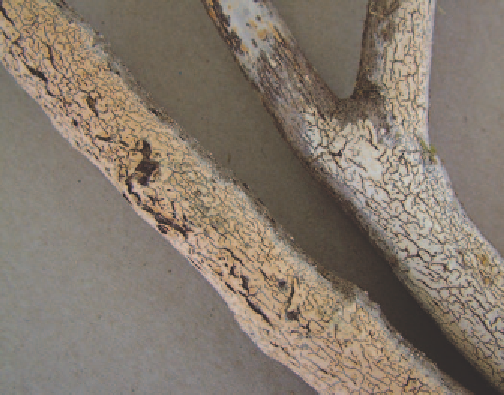Agriculture Reference
In-Depth Information
PINK DISEASE
just behind the feeder root tip. Brown rot develops under
conditions wet enough for spores to be splashed from the
soil onto fruit near the ground. If wet weather persists,
sporangiospores produced on those fruit are splashed
onto other fruit higher in the tree canopy. During manual
harvesting in wet weather, infested soil can be carried up
ladders on citrus pickers' boots and initiate infections
throughout the canopy.
■
Cause
The fungus
Erythricium salmonicolor
.
Symptoms
The fungus spreads rapidly along the bark under
humid conditions, forming a smooth, pink encrustation of
hyphae. Over time, the fungus penetrates and kills the
bark, which dries and fades to a grey colour. Infected
branches show signs of gumming and may be ringbarked,
leading to death of major limbs or entire trees.
Phytophthora
species survive unfavourable periods as
resistant spores in the soil or as hyphae or sporangia in
decayed roots of previously infected hosts.
Importance
Phytophthora diseases are very serious in wet coastal
orchards and in inland areas where citrus are irrigated on
shallow, marginal soils with poor internal drainage. Brown
rot is particularly troublesome in areas prone to autumn
and winter rainfall. The scions at greatest risk are lemons,
limes, sweet orange, grapefruit and Cleopatra mandarin.
The most tolerant rootstocks include
Poncirus trifoliata
,
Troyer and Carrizo citrange, and Swingle cutrimelo.
Susceptible rootstocks include rough lemon, sweet orange,
Cleopatra mandarin and Volkameriana. However,
susceptibility depends on the
Phytophthora
species present.
Source of infection and spread
The fungus attacks many woody species besides citrus. Wet,
humid weather and the persistence of moisture in shaded,
poorly ventilated areas in an orchard favour the fungus.
Importance
The disease can be serious in wet tropical regions. It also
occurs in moist, subtropical coastal areas, particularly in
blocks adjacent to rainforest.
Management
•
Prune diseased branches as soon as they are detected.
Paint cuts with the recommended fungicide and burn
prunings.
Management
•
Keep canopies open to allow air movement and light
penetration to keep the humidity low.
•
Plant pathogen-free trees from a Nursery Industry
Accreditation Scheme Australia nursery. Plant no deeper
than they were in the nursery, into deep, well-drained
soils. Ensure nursery trees have been budded high above
the soil line.
Once the disease has been detected, inspect the orchard
regularly, particularly during the summer months.
•
Avoid over-watering trees and make sure sprinklers do
not spray directly onto the trunk for long periods.
•
Avoid damaging bark during cultural operations.
•
Control weeds, keep mulch away from trunks and skirt
trees to allow good air movement.
•
Use rootstocks tolerant of the
Phytophthora
species presents,
and treat fi eld soil and nursery trees with registered
products prior to planting, particularly in replant areas.
•
In trees with collar rot, pare away the infected bark
and one centimetre beyond, then paint the site with a
recommended registered fungicide to protect trees from
infection.
•
Brown rot can be reduced by spraying the trunk, fruit
and foliage below a height of 1.5 m with the registered
fungicides, as required under the prevailing weather
conditions.
•
Fig 6.36 Symptoms of pink disease on a stem. Note the pink and
white fungal encrustation.












